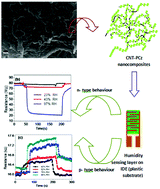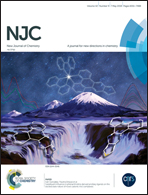Non-covalent functionalization of CNTs with polycarbazole: a chemiresistive humidity sensor with tunable chemo-electric attributes at room temperature†
Abstract
This article describes the non-covalent functionalization of multiwall carbon nanotubes (MWCNTs) with polycarbazole (PCz) via an in situ chemical oxidative polymerization method and subsequent fabrication of resistive humidity sensors. The morphological and optical characterizations have been performed using electron microscopy and UV-visible spectroscopy. The performance of the CNT–PCz sensors has been studied for the resistive detection of humidity ranging from 23% RH to 97% RH. The optimum level of CNT loading is assessed by varying the concentration of the nanotubes in the PCz matrix and the highest response (%) was obtained for 1 wt% MWCNT loaded PCz. The observed fast response (13–25 s) and recovery time (22–65 s) along with a considerable response (%) towards humidity render the nanocomposite as a suitable candidate for humidity sensing applications. Interestingly, the humidity sensing properties can be easily switched by varying the CNT concentration in the nanocomposites. Plausible mechanisms are proposed to describe this tunable chemo-electric humidity sensing behavior of the CNT–PCz composites. Further, effort has been made to explain the role of CNTs and polycarbazole in the detection of humidity.



 Please wait while we load your content...
Please wait while we load your content...